Structure of the Environmental Plan Package
Anticipating a time 30 years in the future, in October 2020 MITSUBISHI MOTORS formulated the Environmental Plan Package, which defines the directions and targets of its environmental initiatives. This package establishes the foundation for our directions on environment-related management strategy, outlining our objectives for realizing a sustainable society, including one that is carbon-neutral, as we conduct our business activities. The Environmental Plan Package comprises the Environmental Policy, which we have revised to incorporate our medium- to long-term perspective; the Environmental Vision 2050, which sets out our vision for society to be achieved by 2050 and directions for our initiatives; and the Environmental Targets 2030, which clarifies specific initiatives to be achieved by 2030 in accordance with this vision.
Environmental Policy
We have been acting in accordance with its Environmental Policy, which was formulated in 1999. However, in the 20 years that have passed since that time the operating environment has changed, prompting us to revise the policy in 2020 to reflect current social trends. We recognize that responding to environmental issues in our business activities is essential, and so have newly incorporated a medium- to long-term outlook into our policy.
Focusing specifically on climate change, resource depletion and environmental pollution, we aim to contribute to the preservation of water resources and biodiversity through initiatives in these areas.
Environmental Policy
Mitsubishi Motors recognizes that responding to environmental issues through its business activities is essential. Accordingly, we will engage proactively in specific and effective measures from a medium- to long-term perspective. (Directions of initiatives)
- We will face three specific environmental issues headon: climate change, resource depletion and environmental pollution.
- Given that 2050 is an important landmark for climate change on a global scale, we have clarified levels to be achieved, in 10-year increments, and are pursuing initiatives to this end.
- We will respond to environmental issues through the following activities:
- Unique environmental contributions through our products
- Initiatives at each stage of automobile production, sale and use
- Collaboration with business partners, affiliated institutions, governments and local authorities
- Initiatives targeting environmental issues rooted in the local community
- Initiatives to determine and reduce environmental impact of all related business activities
Environmental Vision 2050
Members of the Paris Agreement, adopted in 2015, agreed to limit the rise in average global temperatures to substantially less than 2°C above levels before the Industrial Revolution From this basis, we established initiatives to pursue from a long-term perspective, leading up to 2050. In 2018, the Intergovernmental Panel on Climate Change (IPCC) published the Special Report on Global Warming of 1.5°C, which calls for society as a whole to achieve a net-zero balance between human-caused greenhouse gas emissions and absorption.
As these measures illustrate, awareness of climate change and other environmental issues is rising each year. Companies are also being called upon to undertake more ambitious initiatives.
Against this backdrop, we formulated the Environmental Vision 2050, which sets out our vision for society to be achieved by 2050, as well as directions for our initiatives, with regard to climate change, resource circulation and pollution prevention.
Working to Become Carbon Neutral by 2050
Regarding “action to climate change,” we have stated our commitment toward helping to shape a society resilient to the impact of climate change by achieving net-zero CO2 emissions. In September 2022, we revised Environmental Vision 2050, incorporating the goal of achieving carbon neutrality.
Environmental Vision 2050
In December 2015, the Paris Agreement was adopted at COP21. Members of this accord agreed to curtail the rise in average global temperatures to 2°C above levels before the Industrial Revolution and to work to keep the rise to 1.5°C. Given such social demands, MITSUBISHI MOTORS believes it can contribute toward the realization of a sustainable society, achieving a balance between the progress of humankind and the global environment, through the proliferation of electrified vehicles and the promotion of their use in society.
| Action to Climate Change | Resource Circulation | Pollution Prevention |
|---|---|---|
| Through electrified vehicles and the increased use of renewable energy, we aim to become carbon neutral and contribute to the realization of a society that is resilient to climate change. | We will contribute to a resource-recycling-oriented society by minimizing input resources and maximizing resource efficiency. | We will contribute toward a society free of environmental pollution affecting human health and the ecosystem by reducing the environmental impact of our products and the pollution resulting from our business activities. |
Environmental Targets 2030
MITSUBISHI MOTORS has formulated Environmental Targets 2030, which are items to be addressed over the next 10 years in line with the direction of society and initiatives to be pursued 30 years into the future, as set forth in our Environmental Vision 2050. In setting targets, we referred to scenarios published by the IEA*1 and the IPCC, as well as international frameworks such as the SDGs and the Paris Agreement.
We revised the Environmental Targets 2030 in February 2023, setting even higher targets in our“action to climate change” to demonstrate our commitment to achieving carbon neutrality. For Scope 1*2 and Scope 2*3, we raised our target for reducing CO2 emissions from business activities to the SBT*4 target equivalent to a 1.5°C level. For Scope 3*5, in addition to an electrified vehicles sales ratio of “50% by FY2030,”we added “100% by FY2035.” We also added qualitative targets related to procurement and distribution. These revisions were approved by the Board of Directors.
- IEA:Internal Energy Agency
- Scope1:A company’s direct emissions (such as from burning fuel)
- Scope2:Indirect emissions, resulting from electricity, heat or steam provided by another company
- SBT: Short for Science Based Targets, which are greenhouse gas emission reduction targets set by companies consistent with the Paris Agreement levels
- Scope 3: Indirect emissions other than Scope 1 and Scope 2 (emissions from other companies and other sources related to the company’s activities)
Environmental Targets 2030
| Issues | Targets 2030 | |
|---|---|---|
| Climate Change | Average CO2 emissions from new vehicles*6 |
-40% (compared with FY2010) |
| Electrified vehicles*7 sales ratio |
50% FY2035 100% |
|
| CO2 emissions from business activities*8 |
-50% (compared with FY2018) |
|
| Promoting CO2 reduction activities with major suppliers | ||
| Promoting CO2 reduction activities in cooperation with logistics companies | ||
| Providing energy management services utilizing electrified vehicles and used batteries | ||
| Implementing measures to adapt to climate change | ||
| Resource Circulation | Expanding adoption of non-fossil-based plastic | |
| Achievement of zero direct landfill waste (less than 0.5%) |
||
| Reuse of batteries used in electrified vehicles | ||
| Pollution Prevention | Conformance to regulations on use of substances of concern in products | |
| Environmental Management |
|
|
- CO2 emissions per new vehicle while driving. Tank to Wheel
- Battery Electric vehicles, plug-in hybrid electric vehicles (PHEV), and hybrid electric vehicles
- Total of Scope 1 Scope 2
- LCA stands for life cycle assessment, which is a technique for calculating and evaluating the environmental impact of a product from manufacturing to disposal.
Principal Results for FY2024
-
Average CO2 emissions from new vehicles
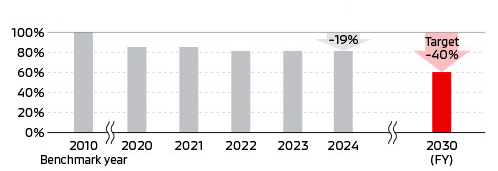
-
Ratio of electrified vehicles sold*10
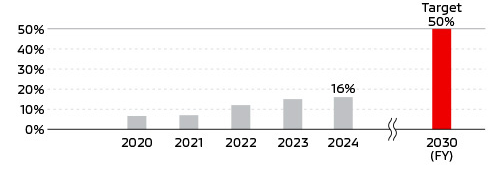
- Based on number of wholesale units sold.
-
CO2 emissions from business activities*11
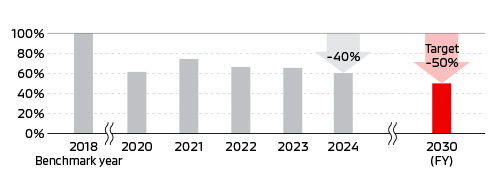
- Scope 1 and Scope 2
- The officially reported emission volume of FY2018 (the benchmark year), was 588 thousand t-CO2. This volume includes 43 thousand t-CO2 emissions from some equity-method associates.
For the purposes of target setting, we have revised our base figure to 545 thousand t-CO2, as our current method of selecting environmental management target companies excludes these equity-method associates.
Structure for Consideration in Formulation
To clarify MITSUBISHI MOTORS’ policies and plans in the environmental area and strengthen a series of initiatives, in 2018 we established a cross-company environmental working group to develop an environmental planning package.
After certain directions had been determined, a small circle chaired by the then-CEO moved forward to specifics. These were approved by the Board of Directors.
〈Structure for Consideration from July 2018 to December 2019〉
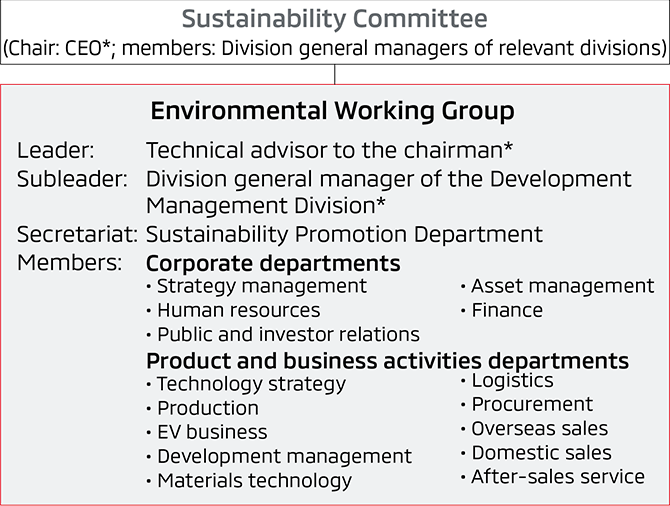
〈January–October 2020〉
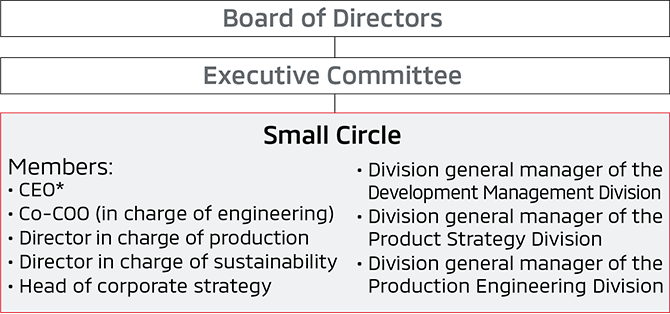
- Positions as of March 2020
Steps to Formulation
The Environmental Working Group we set up in FY2018 gathered data related to global social changes, such as economic growth and population increase, as well as environmental issues. In particular, the group looked for information on regions of importance to our business, ascertaining the status of local communities and government environmental policies. We also looked at unit sales and the number of vehicles owned in each country, arranging this data to match our business characteristics by looking at our business data and results of environmental initiatives. The group also summarized our efforts to date.
Using this data, we then verified each of the environmental issues and our relationship to them. We identified three environmental issues to face head-on: action to climate change, resource circulation and pollution prevention. We considered the long-term outlook for these environmental issues by studying external scenarios from the IEA and IPCC, as well as by running our own simulations. We then arranged the issues to be addressed by thinking about how to contribute in a manner tailored to local communities while maximizing our strengths, looking at each market from a regional perspective and considering plug-in hybrid electric vehicles (PHEV) and other business characteristics.
Based on this analysis, we clearly spelled out the directions for initiatives indicated in the Environmental Policy and Environmental Vision 2050 and set numerical targets for the items in the Environmental Targets 2030. In this way, we formulated the New Environmental Plan Package, which provides an overall summary of our environmental strategies.
In the final process of formulation, we incorporate the perspectives of our stakeholders by conducting reviews by external experts.
Going forward, we will continue to accumulate and analyze information on social trends and confirm the appropriateness of our Environmental Plan Package.
| Gathering of Information |
|
|---|---|
| Analysis |
|
| Formulation |
|
| Review |
|